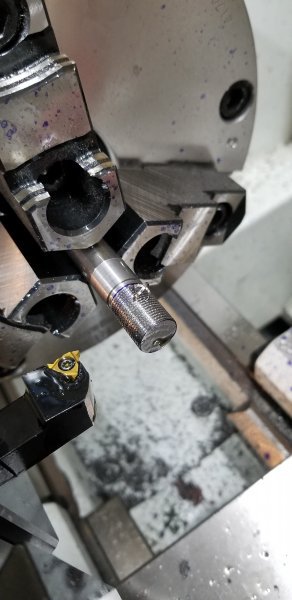- Joined
- Mar 22, 2013
- Messages
- 497
Hey Guys, I have someone I am trying to help with the thread finish on his machine. Please see the attached photo.
Has anyone ever seen anything like that before? Material is 4140 and you can see the cutter being used. We have covered everything I can possibly think of with the lathe. He says that a year ago on this machine, this was not happening, but now it is. Finish when using a turning tool is fine, this is only when threading. Which is so strange to me, because turning and threading is the same thing, other than the shape and using the lead screw instead of the feed rod.
I have tried to duplicate this thread, and the only way I could do it on my machine was to just dig way too deep during passes. Not the same finish, but bad.
This is a list of what we have covered, so many hours over the last few weeks:
1. Spindle bearings
2. Its a 3 phase motor, was on a phase converter, now on a VFD. Seems to have improved some with the VFD, but still not good.
3. Belts
4. Tool post and compound, cross slide, all tight, he can not feel any vibration if he puts his hand on when cutting, but the finish is there
5. No strange noises coming from the machine, all shafts and bearings feel smooth
6. Chuck jaws not loose, also tried another chuck, same thing
Any ideas at all? Has anyone ever seen anything like this?
Thank you in advance!
Has anyone ever seen anything like that before? Material is 4140 and you can see the cutter being used. We have covered everything I can possibly think of with the lathe. He says that a year ago on this machine, this was not happening, but now it is. Finish when using a turning tool is fine, this is only when threading. Which is so strange to me, because turning and threading is the same thing, other than the shape and using the lead screw instead of the feed rod.
I have tried to duplicate this thread, and the only way I could do it on my machine was to just dig way too deep during passes. Not the same finish, but bad.
This is a list of what we have covered, so many hours over the last few weeks:
1. Spindle bearings
2. Its a 3 phase motor, was on a phase converter, now on a VFD. Seems to have improved some with the VFD, but still not good.
3. Belts
4. Tool post and compound, cross slide, all tight, he can not feel any vibration if he puts his hand on when cutting, but the finish is there
5. No strange noises coming from the machine, all shafts and bearings feel smooth
6. Chuck jaws not loose, also tried another chuck, same thing
Any ideas at all? Has anyone ever seen anything like this?
Thank you in advance!


